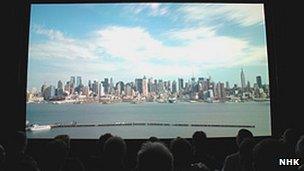Super Hi-Vision 8K TV standard approved by UN agency
- Published
- comments

A new high-resolution television format has been approved by the UN's communication standards setting agency.
Broadcasts in 8K will offer a resolution of 7,680 by 4,320 pixels - roughly the equivalent of a 32 megapixel photo.
That is 16 times as sharp as current HD TVs offering about 2MP resolutions.
Japanese broadcaster NHK showed off the technology in London during the Olympics, where audiences said it gave them a sense of being at the events.
The firm has developed three cameras that can capture the higher resolution - which it calls Super Hi-Vision - at 60 frames per second but aims to double that to 120 frames per second.
By contrast the BBC currently broadcasts HD TV programmes at 25 fps.
"The experience of viewing and listening to live sports and entertainment coverage is dramatically enhanced by Super Hi-Vision, and Ovum envisages it representing the logical next step in TV transmission technology, following on from regular HD," wrote the consultancies' analyst Jonathan Doran in a report.
"In our view, it is a far more significant development than 3D, which offers a limited range of use-cases."
Mega screens
The UN's International Telecommunication Union (ITU) discussed the standard in May and offered broadcasters the opportunity to file objections. Because no-one did, it sent out letters at the end of last week confirming the format's approval.
A press release from NHK said the specification would "reproduce the feeling of life and offer a sense of being present" in a way that had been impossible to do before. The news was first reported by Techworld.
NHK has used a 145-inch (3.7 metre) prototype display co-developed with Panasonic to show off its footage.
But it will be some time before such models become commercially available.
TV makers are currently focusing efforts on launching 4K enabled devices offering a quarter of the resolution. This is the format currently used by most digital cinema cameras.
LG unveiled the biggest 4K television set to date earlier this week - an 84 inch screen costing more than $22,000.
But manufacturers are likely to want to offer 8K screens by 2020 when NHK aims to begin its first experimental broadcasts in the standard.
Photographers' friend
One analyst said the displays would probably remain beyond most people's budgets for more than a decade.
"I suspect that we won't see this become available to consumers below $10,000 until 2025," Paul O'Donovan, principal analyst at the tech consultancy Gartner, told the BBC.
"Those will be in sizes 55 inches and above. You will still get a benefit at that size because it offers a greater colour depth and contrast as well as a sharper picture.
"But when the screens are even larger you get a sense of being there - it's like looking through a window.
"Beyond better looking TV programmes they will also appeal to photographers. Many people have cameras with lots of megapixels and this gives them a way to see their pictures back at the same resolution they took them in."
- Published31 July 2012
- Published22 August 2012
- Published5 October 2010
- Published17 July 2012